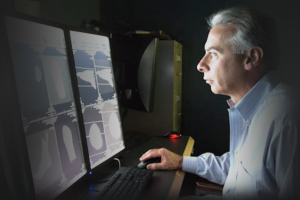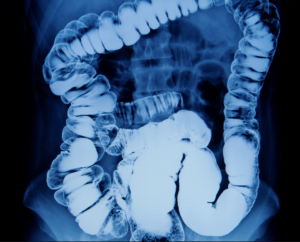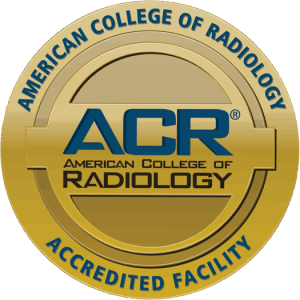FLUOROSCOPY
What is Fluoroscopy?
 Fluoroscopy is a study of moving body structures – similar to an x-ray “movie.” A continuous x-ray beam is passed through the body part being examined, and is transmitted to a TV-like monitor so that the body part and its motion can be seen in detail.
Fluoroscopy is a study of moving body structures – similar to an x-ray “movie.” A continuous x-ray beam is passed through the body part being examined, and is transmitted to a TV-like monitor so that the body part and its motion can be seen in detail.
Fluoroscopy, as an imaging tool, enables physicians to look at many body systems, including the skeletal, digestive, urinary, respiratory, and reproductive systems. Fluoroscopy may be performed to evaluate specific areas of the body, including the bones, muscles, and joints, as well as solid organs such as the heart, lung, or kidneys.
Fluoroscopy is used in many types of examinations and procedures, such as barium x-rays, cardiac catheterization, arthrography (visualization of a joint or joints), lumbar puncture, placement of intravenous (IV) catheters (hollow tubes inserted into veins or arteries), intravenous pyelogram, hysterosalpingogram, and biopsies.
Fluoroscopy may be used alone as a diagnostic procedure, or may be used in conjunction with other diagnostic or therapeutic media or procedures.
In barium x-rays, fluoroscopy used alone allows the physician to see the movement of the intestines as the barium moves through them. In cardiac catheterization, fluoroscopy is added to enable the physician to see the flow of blood through the coronary arteries in order to evaluate the presence of arterial blockages. For intravenous catheter insertion, fluoroscopy assists the physician in guiding the catheter into a specific location inside the body.
Other uses of fluoroscopy include, but are not limited to, the following:
- Locating foreign bodies
- Viscosupplementation injections of the knees – a procedure in which a liquid substance that acts as a cartilage replacement or supplement is injected into the knee joint
- Image-guided anesthetic injections into joints or the spine
- Percutaneous vertebroplasty – a minimally invasive procedure used to treat compression fractures of the vertebrae of the spine
FLUOROSCOPY PROCEDURES AT LAKES RADIOLOGY
Lakes Radiology is equipped with two fluoroscopy suites offering our referring physicians a wide range of procedures including:
- Esophagram (Barium Swallow)
- Upper GI Series
- Small Bowell Series
- Barium Enema
- Barium Enema with Air Contrast
- IVP
What is An esophagram?
 An esophagram is a series of X-Rays that are taken while a patient is swallowing , that allows for visualization of the entire length of the esophagus and any areas of obstruction or narrowing. The patient swallows a special liquid that is visible on the X-ray, such as barium or gastrografin, and the X-ray machine takes a continuous run of photos from various angles as the patient swallows.
An esophagram is a series of X-Rays that are taken while a patient is swallowing , that allows for visualization of the entire length of the esophagus and any areas of obstruction or narrowing. The patient swallows a special liquid that is visible on the X-ray, such as barium or gastrografin, and the X-ray machine takes a continuous run of photos from various angles as the patient swallows.
What is a Barium enema?
 Barium enemas are low risk and often less expensive than a colonoscopy. They are commonly used to diagnose colorectal cancer and inflammatory disease. But it doesn’t end there, barium enemas also help detect polyps, diverticulum (a pouch pushing out from the colon) and structural changes in the large intestine.
Barium enemas are low risk and often less expensive than a colonoscopy. They are commonly used to diagnose colorectal cancer and inflammatory disease. But it doesn’t end there, barium enemas also help detect polyps, diverticulum (a pouch pushing out from the colon) and structural changes in the large intestine.
ACR Accreditation
 Lakes Radiology is an Accredited Facility with the American College of Radiology. ACR Accreditation is recognized as the gold standard in medical imaging since 1987.
Lakes Radiology is an Accredited Facility with the American College of Radiology. ACR Accreditation is recognized as the gold standard in medical imaging since 1987.
The American College of Radiology® (ACR®) is a nonprofit professional society representing radiologists, nuclear medicine physicians, radiation oncologists and medical physicists. It is the largest and oldest imaging accrediting body in the U.S., with a current membership of 39,000 physicians and medical physicists. The core purpose of the ACR is to serve patients and society by empowering its members to advance the practice, science and professions of radiological and radiation oncology care.
Schedule an appointment
To schedule an appointment at Lakes Radiology please call (305) 231-1115 or fill out the form below.
Our Services
Business Hours
- Monday
- Tuesday
- Wednesday
- Thursday
- Friday
- Saturday
- Sunday
- 8AM - 5PM
- 8AM - 5PM
- 8AM - 5PM
- 8AM - 5PM
- 8AM - 5PM
- 8AM - 3PM
- Closed
